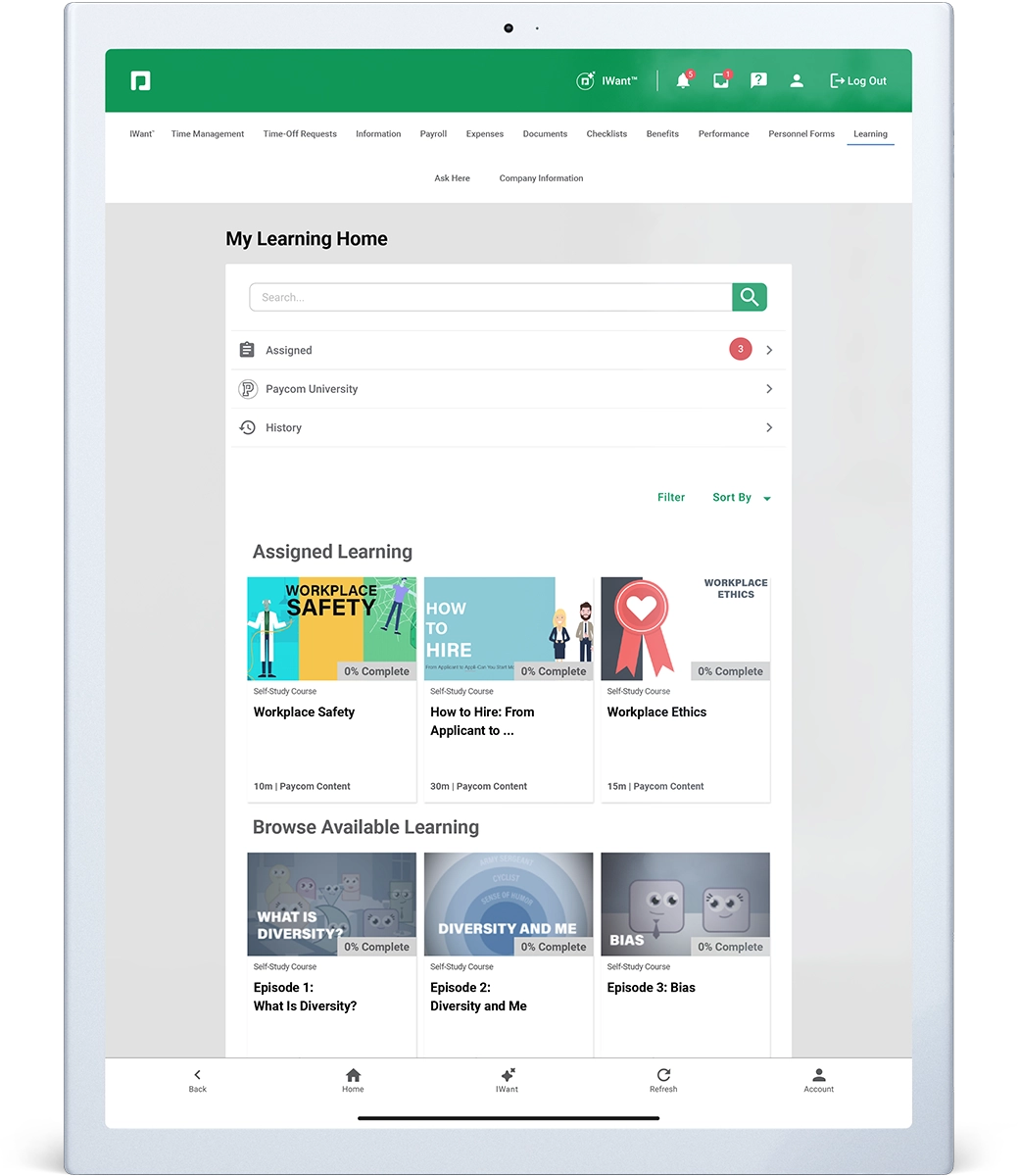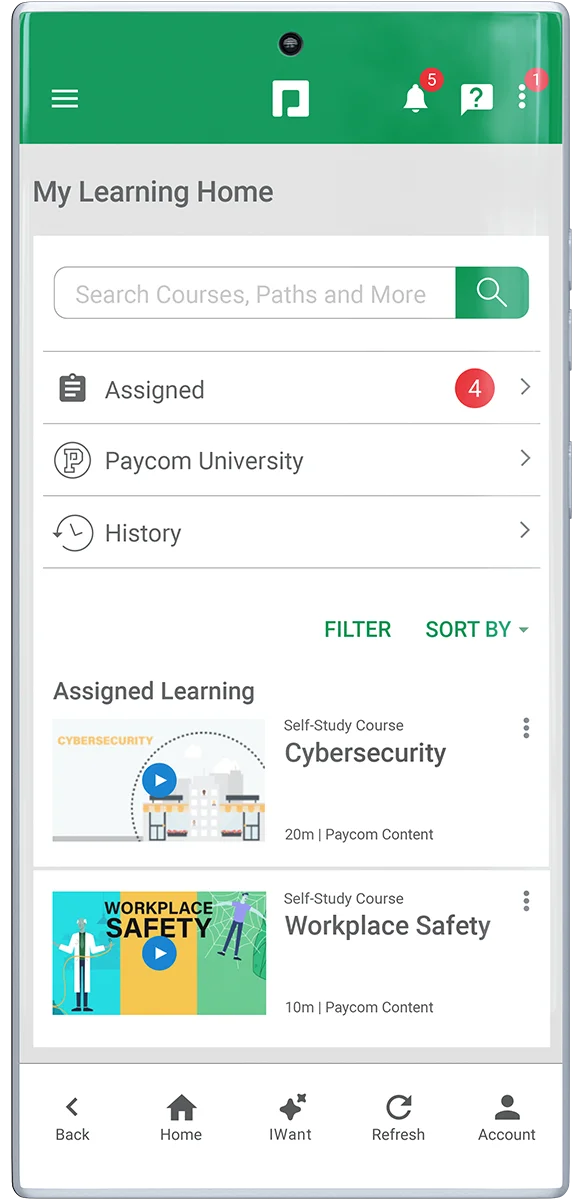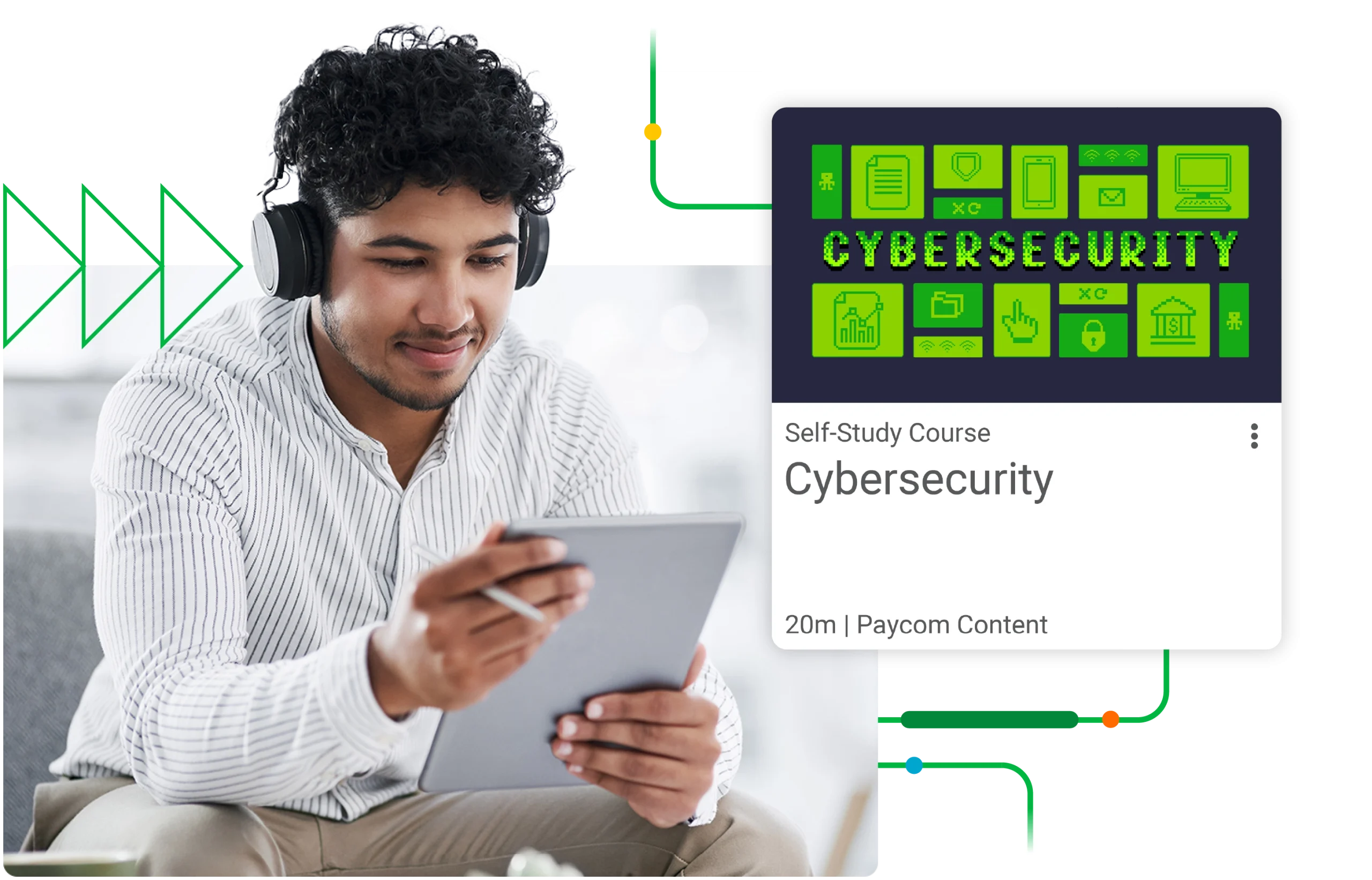Paycom learning
Easily and consistently train your employees with learning management software as you engage them with ongoing development


What it does
Keep your workforce on the cutting edge

Training your team doesn’t have to be a trial. Paycom’s learning management system allows you to easily and consistently train, upskill and reskill your workforce for compliance, development and a positive company culture — all in our single software. You can focus on the bigger picture while our intuitive, scalable experience provides the mobile-friendly training today’s workers expect, keeping them current on job-specific skills and company policies.
How it’s different
Make skills development a priority
Put them on the right path
Configure learning paths based on skill, workplace, industry needs, compliance requirements and more. Plus, you can assign training based on location, role or certification requirements.
Anytime, anywhere learning
Give your team the training to grow no matter where they are. Our online learning management system offers an intuitive, mobile-friendly training experience today’s workers want and expect. And our video content creator feature lets trainers and managers record and upload training videos right from our mobile app.
Stop stressing about compliance
Paycom Learning makes it easy to assign legally required training, track course completions and schedule recurring courses to help ensure your workforce stays compliant and informed.

Let them learn at their pace
Support engagement, retention and career development with self-guided learning that gives employees a sense of ownership and lets them tackle training when they’re ready. Our performance evidence feature even lets them record short videos proving their understanding of the material.
Track training without the hassle
Our course status dashboard immediately begins monitoring progress on assigned learnings, so you can easily keep tabs on employee development and potential skills gaps.
Simplify onboarding and testing
Make it simple for new hires to begin training and orientation before Day 1. Prepare them by creating quizzes that use a variety of question types, including multiple-choice, true-false, drop-down and short-answer — whichever works best for you.
Put them on the right path
Configure learning paths based on skill, workplace, industry needs, compliance requirements and more. Plus, you can assign training based on location, role or certification requirements.
Anytime, anywhere learning
Give your team the training to grow no matter where they are. Our online learning management system offers an intuitive, mobile-friendly training experience today’s workers want and expect. And our video content creator feature lets trainers and managers record and upload training videos right from our mobile app.
Stop stressing about compliance
Paycom Learning makes it easy to assign legally required training, track course completions and schedule recurring courses to help ensure your workforce stays compliant and informed.
Let them learn at their pace
Support engagement, retention and career development with self-guided learning that gives employees a sense of ownership and lets them tackle training when they’re ready. Our performance evidence feature even lets them record short videos proving their understanding of the material.
Track training without the hassle
Our course status dashboard immediately begins monitoring progress on assigned learnings, so you can easily keep tabs on employee development and potential skills gaps.
Simplify onboarding and testing
Make it simple for new hires to begin training and orientation before Day 1. Prepare them by creating quizzes that use a variety of question types, including multiple-choice, true-false, drop-down and short-answer — whichever works best for you.
See what people are saying about Paycom
Comprehensive convenience
Paycom Learning seamlessly connects with
Employees can easily train anytime, anywhere through our self-service software — via desktop or mobile app. It’s secure and convenient and empowers your people to manage their own development.
Our document management software makes it easy to create checklists of courses for employees to complete like new-hire onboarding, leadership training, required health and safety courses, and more.
Ease the burden and stress of staying in compliance by easily running reports on required training. Use predefined reports or create custom reports to fit your unique metrics.
Configuration and compliance
Keep learning on course

Paycom Learning’s content complies with industry best practices, supporting packages of the following file types:
- SCORM 1.1
- SCORM 1.2
- SCORM 2004 (2nd, 3rd and 4th editions)
- Tin Can API
- AICC


Built-in courses

You know compliance is crucial. So do we. That’s why we make it easier with built-in courses at no additional cost. Help ensure compliance companywide by giving employees easily accessible training content and measuring their progress from anywhere.
Built-in courses available for your unlimited use include:
- HIPAA basics
- preventing discrimination and harassment
- workplace ethics
- diversity and inclusion
- cybersecurity
- equal employment opportunities
- and more
Course subscriptions

In addition to built-in content or creating courses, you can add a subscription to offer compliance and management instruction specific to your industries with more than 225 courses in English and Spanish.
Options include:
- safety
- health care
- construction
- hospitality
- manufacturing
- transportation
- and more

Frequently asked questions
Learn more about Paycom Learning
A learning management system is a software tool that helps employers train, upskill and reskill their workforce, as well as maintain compliance, onboard new hires and communicate essential information about organizational processes and policies.
The right learning management system reduces the HR and manager workload of training, upskilling and reskilling employees. Full mobile functionality means employees can complete courses from anywhere, which makes it easier for organizations to stay compliant on employee-required trainings and industry-specific certifications.
With self-guided learning options, Paycom Learning empowers employees to learn at their own pace and apply what they’ve learned to their roles to help support career planning and advancement.
HR professionals, instructional designers and managers can create their own courses with options to add high-quality videos and quizzes. Plus, customized learning paths allow courses to be curated to fit an organization’s unique skills, workplace, industry and compliance needs.
Paycom Learning offers subscription-based courses tailored to specific industries like health care, hospitality, manufacturing, transportation and more.
Yes! HR professionals and managers can monitor employees’ progress with a dashboard view that displays assigned learnings and their statuses.
With learning paths, admin users can automatically assign specific courses to individuals or a group. Employees are then notified when they’ve been assigned a course.
Discover more about Paycom



